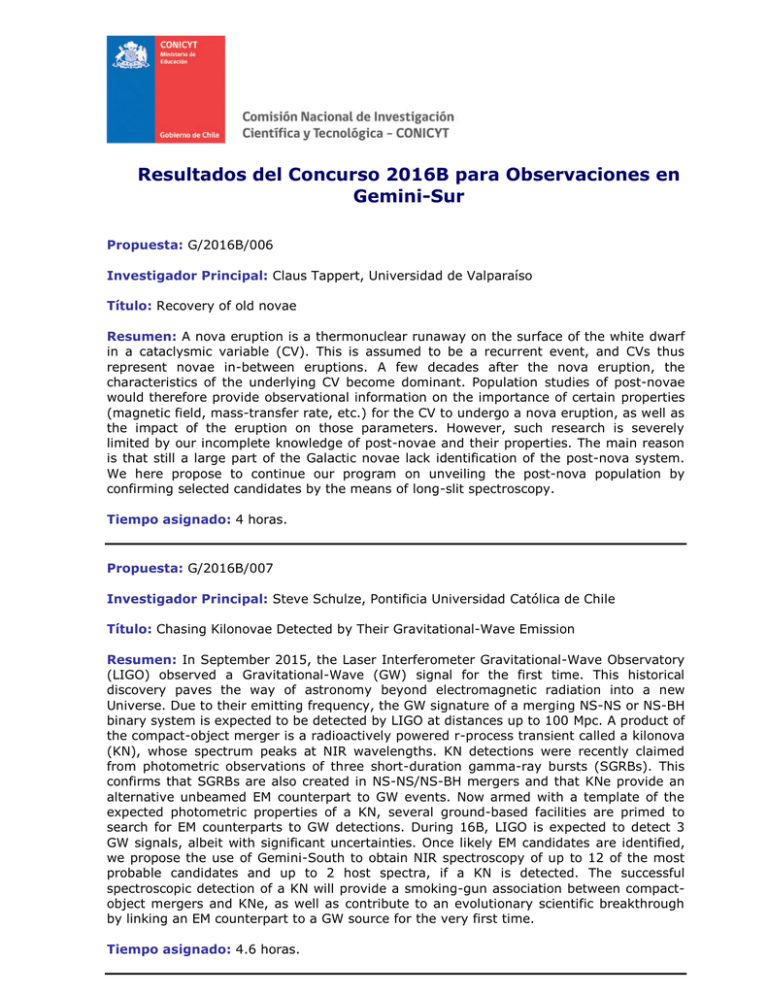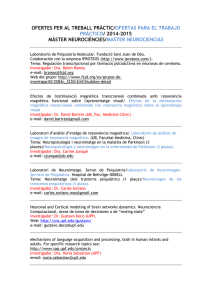Resultados del Concurso 2008A para Observaciones en
Anuncio

Resultados del Concurso 2016B para Observaciones en Gemini-Sur Propuesta: G/2016B/006 Investigador Principal: Claus Tappert, Universidad de Valparaíso Título: Recovery of old novae Resumen: A nova eruption is a thermonuclear runaway on the surface of the white dwarf in a cataclysmic variable (CV). This is assumed to be a recurrent event, and CVs thus represent novae in-between eruptions. A few decades after the nova eruption, the characteristics of the underlying CV become dominant. Population studies of post-novae would therefore provide observational information on the importance of certain properties (magnetic field, mass-transfer rate, etc.) for the CV to undergo a nova eruption, as well as the impact of the eruption on those parameters. However, such research is severely limited by our incomplete knowledge of post-novae and their properties. The main reason is that still a large part of the Galactic novae lack identification of the post-nova system. We here propose to continue our program on unveiling the post-nova population by confirming selected candidates by the means of long-slit spectroscopy. Tiempo asignado: 4 horas. Propuesta: G/2016B/007 Investigador Principal: Steve Schulze, Pontificia Universidad Católica de Chile Título: Chasing Kilonovae Detected by Their Gravitational-Wave Emission Resumen: In September 2015, the Laser Interferometer Gravitational-Wave Observatory (LIGO) observed a Gravitational-Wave (GW) signal for the first time. This historical discovery paves the way of astronomy beyond electromagnetic radiation into a new Universe. Due to their emitting frequency, the GW signature of a merging NS-NS or NS-BH binary system is expected to be detected by LIGO at distances up to 100 Mpc. A product of the compact-object merger is a radioactively powered r-process transient called a kilonova (KN), whose spectrum peaks at NIR wavelengths. KN detections were recently claimed from photometric observations of three short-duration gamma-ray bursts (SGRBs). This confirms that SGRBs are also created in NS-NS/NS-BH mergers and that KNe provide an alternative unbeamed EM counterpart to GW events. Now armed with a template of the expected photometric properties of a KN, several ground-based facilities are primed to search for EM counterparts to GW detections. During 16B, LIGO is expected to detect 3 GW signals, albeit with significant uncertainties. Once likely EM candidates are identified, we propose the use of Gemini-South to obtain NIR spectroscopy of up to 12 of the most probable candidates and up to 2 host spectra, if a KN is detected. The successful spectroscopic detection of a KN will provide a smoking-gun association between compactobject mergers and KNe, as well as contribute to an evolutionary scientific breakthrough by linking an EM counterpart to a GW source for the very first time. Tiempo asignado: 4.6 horas. Propuesta: G/2016B/016 Investigador Principal: Paulina Lira, Universidad de Chile Título: Reverberation Mapping of high-z QSOs: the final stages Resumen: Reverberation mapping provides the only tool for obtaining the Black Holes (BH) mass in Active Galaxies. So far this method has been successfully applied only to low and intermediate luminosity systems (>10e46 ergs/s). We are extending these studies by two orders of magnitude, probing the BLR size (and BH-mass) of luminous AGN at redshift ~2-3, the peak of the Quasar era. Such large, slowly varying systems require a monitoring strategy that will maximise the likelihood of detecting significant variability. Since 2006 we have been monitoring a few docen very luminous Quasars using broad band imaging with the SMARTS consortium. Targets with significant variations have been followed up with the du Pont telescope covering Ly_alpha, SiIV, CIV and CIII. Now we have identified a handfull of sources with significant structure in their continuum and line curves which are very promising to deliver BH mass determinations in the next few years of monitoring. With this Gemini/F2 campaign we want to add the crucial low-ionization MgII line observed at ~10,000-10,600 A, and in some cases Hbeta at ~17500 A, to our monitoring campaign using the long slit capability of F2. Given the brightness of our sources, this would a very economic proposal with a high scientific return. Tiempo asignado: 1.5 horas. Propuesta: G/2016B/008 Investigador Principal: Roger Cohen, Universidad de Concepción Título: Opening the Window to Galaxy Assembly, Part II: Breaking the IR Age-Metallicity Degeneracy Resumen: It is currently problematic to measure ages of Galactic globular cluters (GCs) over the full range of observed metallicities using near-infrared photometry alone, because models cannot reliably reproduce the observed morphology in near-IR color-magnitude diagrams (CMDs). While a handful of isolated cases have provided age measurements over a narrow metallicity range, the ability to measure ages of heavily extincted bulge GCs and extragalactic stellar populations depends on the ability to apply models in the near-IR over a broad range of ages and metallicities, where models demonstrably fail. We address this problem systematically by targeting optically well-studied "mono-metallicity" pairs of GCs with different ages. In this way, we isolate the effects of age from those of chemical abundance variations in order to compare photometry to multiple models over the full extent of GC age-metallicity parameter space, building on our existing GSAOI+GeMS imaging and our recent study of GC giant branches from wide field near-IR imaging. Here, we propose to observe two GCs, one of which was approved in a previous GSAOI program, each completing a mono-metallicity pair in combination with our existing GSAOI imaging. The resulting library of optical-IR fiducial sequences will be made available to the community, allowing the improvement of current evolutionary models, while our near-IR observations of optically well studied clusters will provide a set of templates for direct application to our existing GeMS imaging of bulge GCs, as well as future resolved stellar populations studies beyond the Local Group. Tiempo asignado: 3.5 horas. Propuesta: G/2016B/010 Investigador Principal: Jesús Corral-Santana: Pontificia Universidad Católica de Chile Título: Calibrating the FWHM-K2 relation of quiescent BHs in the NIR Resumen: Only 18 BHs (i.e. ~30% of the total discovered by transient activity) have been dynamically confirmed after 50 years of X-ray surveys. The remaining are lost because they become too faint (optically) in quiescence for current instruments. We have recently presented a new avenue to deepen BH and neutron star searches with the discovery of a correlation between the width (FWHM) of the disc Halpha emission in quiescence and the projected velocity of the donor star K2. This describes a fundamental velocity scaling, which allows measuring mass functions from single epoch low-resolution spectroscopy. Here we propose to calibrate this relation in the near-infrared using the prominent Br-gamma line. This will open a new window to undertake dynamical studies in highly reddened quiescent BHs, a very significant population that have so far eluded follow-up monitoring. We estimate that the proposed calibration will double the current number of dynamical BHs in the near future. Tiempo asignado: 3.2 horas. Propuesta: G/2016B/003 Investigador Principal: Doug Geisler, Universidad de Concepción Título: Accurate Metal Abundances and Kinematics of a Large Sample of Small Magellanic Cloud Star Clusters and Surrounding Fields Resumen: We propose to derive ages, metallicities and velocities, for red giants in 10 star clusters in the Small Magellanic Cloud (SMC). Simultaneously, we will obtain similar data (except for ages) for a number of field stars surrounding each cluster. The Ca triplet efficiently yields excellent velocities and metallicities, and CMDs from preimages provide ages. SMC clusters are an ideal laboratory for unlocking the secrets of cluster and galaxy formation, and are crucial testbeds for stellar evolution models and interpreting the integrated light of distant galaxies. Despite its proximity, we still lack a comprehensive knowledge of the SMC chemical evolution, which should be greatly aided by this investigation. We will compile a definitive dataset for the age-metallicity relation (AMR), metallicity distribution and possible gradients. Our much larger sample of field giants currently available permits comparison of chemical evolution in clusters to the field. Velocities yield the kinematics of both the clusters and field giants, which are important for understanding the structure and formation of this benchmark galaxy. Tiempo asignado: 6 horas. Propuesta: G/2016B/009 Investigador Principal: Santiago Gonzalez-Gaitan, Universidad de Chile Título: New Approaches to Supernova Standardisation for Cosmology Resumen: A new era of supernova (SN) cosmology has begun, requiring new techniques and probes to both reduce the systematic uncertainties and extend the redshift range into the deceleration phase of the expansion history of the Universe. The Dark Energy Survey (DES) offers such an opportunity by discovering thousands of supernovae across a wide range of redshifts with excellent multi-wavelength light-curves. This is the continuation of our successful 2015B program (CL-2015B-020, PI: Galbany) to fully exploit the agreement between DES and the Chilean SN community to develop new and exciting SN cosmological probes through: a) the acquisition of a unique sample of type II supernova spectra at 0.05<z<0.6 to build Tiempo asignado: 14 horas. Propuesta: G/2016B/015 Investigador Principal: Thomas H. Puzia, Pontificia Universidad Católica de Chile Título: The GeMS/GSAOI Galactic Globular Cluster Survey (G4CS) Resumen: Galactic globular cluster are crucial laboratories and benchmarks for our understanding of the nearby and distant universe. We will use the GeMS/GSAOI instrument to obtain deep JHK photometry of all Milky Way globular clusters that were previously observed by the HST/ACS Galactic Globular Cluster Survey and the HST UV Legacy Survey of Galactic Globular Clusters in the UV and optical filters and that are accessible to GSAOI in period 2016B. With these data we will i) study the morphology of near- IR CMDs and determine the internal consistency of model CMD predictions for various JHK filter combinations and test the influence of molecular absorption band variations on theoretical isochrones predictions in the near-IR using abundance measurments from high-resolution spectroscopy, ii) derive absolute GC ages to within a Gyr and corresponding metallicities with uncertainties Delta(Z)~0.1 dex, and iii) use the combined optical/near-IR CMDs to investigate the internal consistency and calibration of various stellar evolution models. Tiempo asignado: 13 horas. Propuesta: G/2016B/002 Investigador Principal: Mariusz Gromadzki, Universidad de Valparaíso Título: Trigonometric parallax of ancient T dwarf WISE0833+0052 (2016B) Resumen: We propose to measure trigonometric parallaxes with GSAOI for fast moving late T dwarfs WISE 0833+0052 with kinematics of the thick-disk/halo. Such objects are very rare, only 5 are published until now. WISE 0833+0052 is the only one object in our sample with a suitable natural guiding star for GSAOI. Knowledge of accurate distance allow us constraints its kinematic, and shed more light on its status and origin. Parallax distance is crucial for this goal, and the colours of our target mean that the near-infrared is optimal for the required high precision astrometry. Additionally thess observations allow us to test binary of WISE 0833+0052. This project is awarded 5h (2x2.5h) in Band 1 in semester 2015B and 2016A. Most of these observations were not executed because of GeMS laser damage after earthquake in Sept 2015. Tiempo asignado: 2.5 horas. Propuesta: G/2016B/017 Investigador Principal: Felipe Olivares E. Universidad Andres Bello Título: Late-time spectroscopy of stripped supernovae: probing the progenitor populations and the final stages of massive star Resumen: We propose spectroscopy of stripped envelope (SE) supernovae (SNe) at >1 yr post explosion. SE SN progenitors are depleted of the envelope, through mass loss propelled by either strong winds of a massive star (ZAMS mass > 25 solar masses) or by interactions in a lower-mass binary system. The nebular spectrum contains important information on the progenitor core mass and the previously ejected circumstellar material (CSM). These properties strongly characterize the progenitor as they constrain its initial mass and mass loss history. Nebular line analysis will provide an initial mass estimate and place the progenitor in the single or binary domains. The CSM also provides clues about binary interaction activities, and mass loss history of the progenitor prior to the explosion. As the SE SN progenitor channel and the final stages of massive star evolution are still not very well understood, this study offers a valuable way of probing the exploding star and its terminal phase otherwise unobservable. Tiempo asignado: 5.6 horas. Propuesta: G/2016B/018 Investigador Principal: Maja Vuckovic, Universidad de Valparaíso Título: The EREBOS Project: Determining the Influence of Substellar Objects on Stellar Evolution Resumen: Planets and brown dwarfs in close orbits around main sequence stars will inevitably interact with their stellar hosts once they ascend the red giant branch. The details and outcomes of these interactions are currently unclear. Recent discoveries of brown dwarfs and planets orbiting post-red giant branch “hot subdwarf” stars implies that the substellar objects are not only sufficient for ejecting the outer layers of a red giant’s atmosphere, but that they can also survive the engulfment phase. Thirty-six new eclipsing hot subdwarf binaries with cool, low-mass companions were discovered from light curves obtained by the OGLE project, tripling the number of known systems. Here we propose timeseries spectroscopic observations of these short-period binaries in order to determine their orbital parameters and, ultimately, the companion masses. The final aim of this project is to use this homogeneously-selected sample to derive the mass distribution of the companions and determine the minimum mass needed to strip off the red-giant envelope and survive the common envelope phase. Tiempo asignado: 12.2 horas. Propuesta: G/2016B/019 Investigador Principal: Sergio Torres-Flores, Universidad de La Serena Título: Disentangling the central ionization mechanism in compact group galaxies Resumen: The so-called transitional or composite galaxies are objects that sit in a transition locus between starforming (SF) galaxies and active galactic nuclei (AGN) in the BPT diagnostic diagrams. These have historically been explained as having a mix of SF and AGN activity in their centers. However, up to now, there is no clear detailed understanding of how these two processes are spatially distributed in the galaxies and how they are linked with each other. A few months ago an important step was made towards understanding the ionization mechanism that is dominant in some of these systems when Rich et al. (2015) obtained IFU spectroscopy of 27 ULIRGS (generally mergers and interacting galaxies that populate the transitional region in the BPT diagram) and showed that surprisingly the main ionization radiation in these galaxies are shocks and star formation. Given the importance of this result we want to do a very similar study for three other galaxies (non ULIRGS), in a different environment (the dense environment of compact groups), and with better spatial resolution (given that our galaxies are in the very nearby universe), to see how ubiquitous this result is. Here we propose to use GMOS/IFU datacubes to determine if shocks and/or AGN and/or star formation are taking place in three galaxies located in compact groups. Using line-maps and diagnostic diagrams we will be able to determine the real nature of these systems, and to determine if the environment plays a role in the nuclear activity of these galaxies. Tiempo asignado: 8 horas. Propuesta: G/2016B/001 Investigador Principal: Matias Gómez, Universidad Andres Bello Título: Wealth alone: wide-field study of a field elliptical with a rich globular cluster system Resumen: Our aim is to perform a wide-field and deep photometric study of the elliptical galaxy NGC 1172 and its globular cluster system (GCS), looking for evidence to reconstruct their evolutionary history. In particular, we are interested in calculating the total globular cluster (GC) population and the specific frequency (S_N, the number of GCs normalized by the absolute visual magnitude of the host galaxy), with a complete areal coverage of its GCS as has not been done so far. Its moderate luminosity (M_V ~ -20), low density environment and populated GCS are characteristics that are not usually seen all together. Tiempo asignado: 2.8 horas. Propuesta: G/2016B/020 Investigador Principal: Osmar Rodriguez, Universidad Andres Bello Título: Testing Type II supernovae as cosmological probes at nearinfrared wavelengths Resumen: We propose to use GMOS-S to take one spectroscopic observation of a sample of Type II supernovae (SNe II) during the plateau phase. From the resulting spectrum we will measure the expansion velocity of the photosphere which, combined with a photometric near-infrared follow-up, can be used to calibrate the SN II absolute brightness at such wavelength. Our targets will be secured by surveys which discoveries we have access. They are brighter than 19th mag and therefore can be observed with Gemini+GMOSS under the worst sky conditions. The requested observations will contribute to assemble a statistically significant data set which will allow us to test once and for all the internal precision of SN II as distance indicator in the near-infrared and to compute an accurate value of the Hubble constant. We believe this project represents a very effective way to obtain relevant astrophysical results using 8m-class telescope under non-optimal observing conditions. Tiempo asignado: 16.8 horas. Propuesta: G/2016B/013 Investigador Principal: Fernanda Urrutia-Viscarra, Universidad de La Serena Título: Metallicity and Stellar Masses across Condor’s Tidal Dwarf Galaxy Resumen: Interacting galaxies are ideal laboratories to study not only star formation but also galaxy formation. We propose to observe a system recently discovered using GALEX data just outside the interacting pair of galaxies NGC6872/IC4970. This system has the general characteristics of a young tidal dwarf galaxy (TDG), but metallicity is crucial for us to determine its stellar mass through Spectral Energy Distribution (SED) fitting and thus its nature. NGC 6872, also known as the Condor galaxy, is the largest-known spiral galaxy, with its disk extending for more than 160 kpc and containing regions with very different SEDs across the galaxy. This TDG-candidate is one of its the bluest regions. We propose to obtain two GMOS long-slit spectra and u and i imaging to map star formation and stellar mass across this TDG, building from our previous studies including only UV GALEX data. These SED fittings will include the proposed GMOS u and i imaging, complementing our current data from GALEX (FUV and NUV), Spitzer (3.6 and 4.5 microns), and GMOS (g and r). Tiempo asignado: 4.4 horas.



